Hygrothermal Ageing Influence on BVI-Damaged Carbon/Epoxy Coupons under Compression Load
Abstract
:1. Introduction
2. Materials and Methods
2.1. Tested Materials
- compression specimens: 140 mm × 30 mm × 4.2 mm,
- DMA coupons: 50 mm × 5.6 mm × 4.2 mm.
2.2. Impact Tests
2.3. Accelerated Ageing and Mass Variation
2.4. DMA Tests
2.5. CLC Tests
2.6. Micrographs
3. Results and Discussion
3.1. Impact Tests Results
3.2. Accelerated Ageing and Absorption Data
3.3. Effect of Ageing on Tg
3.4. Effect of Ageing on Compressive Behaviour
3.5. Micrographs
4. Conclusions
Author Contributions
Funding
Institutional Review Board Statement
Informed Consent Statement
Data Availability Statement
Conflicts of Interest
References
- Selzer, R.; Friedrich, K. Mechanical properties and failure behaviour of carbon fibre-reinforced polymer composites under the influence of moisture. Compos. Part A Appl. Sci. Manuf. 1997, 28, 595–604. [Google Scholar] [CrossRef]
- Yao, J.; Ziegmann, G. Equivalence of moisture and temperature in accelerated test method and its application in prediction of long-term properties of glass-fiber reinforced epoxy pipe specimen. Polym. Test. 2006, 25, 149–157. [Google Scholar] [CrossRef]
- Alessi, S.; Conduruta, D.; Pitarresi, G.; Dispenza, C.; Spadaro, G. Accelerated ageing due to moisture absorption of thermally cured epoxy resin/polyethersulphone blends. Thermal, mechanical and morphological behaviour. Polym. Degrad. Stab. 2011, 96, 642–648. [Google Scholar] [CrossRef]
- Mistry, J. Theoretical investigation into the effect of the winding angle of the fibres on the strength of filament wound GRP pipes subjected to combined external pressure and axial compression. Compos. Struct. 1992, 20, 83–90. [Google Scholar] [CrossRef]
- Barbosa, A.P.; Fulco, A.P.; Guerra, E.S.; Arakaki, F.K.; Tosatto, M.; Costa, M.C.; Melo, J.D. Accelerated aging effects on carbon fiber/epoxy composites. Compos. Part. B Eng. 2017, 110, 298–306. [Google Scholar] [CrossRef]
- Tian, W.; Hodgkin, J. Long-term aging in a commercial aerospace composite sample: Chemical and physical changes. J. Appl. Polym. Sci. 2010, 115, 2981–2985. [Google Scholar] [CrossRef]
- Aniskevich, A.; Glaskova-Kuzmina, T. Effect of Moisture on Elastic and Viscoelastic Properties of Fiber Reinforced Plastics: Retrospective and Current Trends. In Creep and Fatigue in Polymer Matrix Composites; Elsevier: Amsterdam, The Netherlands, 2019; pp. 83–120. ISBN 9780081026014. [Google Scholar]
- Mercier, J.; Bunsell, A.; Castaing, P.; Renard, J. Characterisation and modelling of aging of composites. Compos. Part A Appl. Sci. Manuf. 2008, 39, 428–438. [Google Scholar] [CrossRef] [Green Version]
- Miller, S.G.; Roberts, G.D.; Bail, J.L.; Kohlman, L.W.; Binienda, W.K. Effects of hygrothermal cycling on the chemical, thermal, and mechanical properties of 862/W epoxy resin. High Perform. Polym. 2012, 24, 470–477. [Google Scholar] [CrossRef]
- Fulco, A.P.P.; de Medeiros, A.M.; Tonatto, M.L.P.; Amico, S.C.; Talreja, R.; Melo, J.D.D. Fatigue damage and fatigue life diagrams of a carbon/epoxy cross ply laminate aged by hygrothermal exposure. Compos. Part A Appl. Sci. Manuf. 2019, 127, 105628. [Google Scholar] [CrossRef]
- Kaelble, D.H.; Dynes, P.J.; Maus, L. Hydrothermal Aging of Composite Materials: Part 1: Interfacial Aspects. J. Adhes. 1976, 8, 121–144. [Google Scholar] [CrossRef]
- Marom, G.; Broutman, L.J. Moisture penetration into composites under external stress. Polym. Compos. 1981, 2, 132–136. [Google Scholar] [CrossRef]
- Mijović, J.; Lin, K.-F. The effect of hygrothermal fatigue on physical/mechanical properties and morphology of neat epoxy resin and graphite/epoxy composite. J. Appl. Polym. Sci. 1985, 30, 2527–2549. [Google Scholar] [CrossRef]
- Dell’anno, G.; Lees, R. Effect of water immersion on the interlaminar and flexural performance of low cost liquid resin infused carbon fabric composites. Compos. Part B Eng. 2012, 43, 1368–1373. [Google Scholar] [CrossRef] [Green Version]
- Melo, R.Q.C.; Lia Fook, M.V.; Lima, A.G.B. Non-fickian moisture absorption in vegetable fiber reinforced polymer composites: The effect of the mass diffusivity. Polymers 2021, 13, 761. [Google Scholar] [CrossRef] [PubMed]
- Cerbu, C.; Cosereanu, C. Moisture Effects on the Mechanical Behavior of Fir Wood Flour/Glass Reinforced Epoxy Composite. Bioresources 2016, 11, 8364–8385. [Google Scholar] [CrossRef] [Green Version]
- Collings, T.A.; Stone, D.E.W. Hygrothermal effects in CFRP laminates: Strains induced by temperature and moisture. Composites 1985, 16, 307–316. [Google Scholar] [CrossRef]
- ASTM International. Standard Test Method for Moisture Absorption Properties and Equilibrium Conditioning of Polymer Matrix Composite Materials; ASTM International: West Conshohocken, PA, USA, 2010; Volume 92, pp. 1–13. [Google Scholar]
- Cao, S.; Wu, Z.; Wang, X. Tensile properties of CFRP and hybrid FRP composites at elevated temperatures. J. Compos. Mater. 2009, 43, 315–330. [Google Scholar]
- Peters, P.W.M.; Andersen, S.I. The Influence of Matrix Fracture Strain and Interface Strength on Cross-Ply Cracking in CFRP in the Temperature Range of −100 °C to +100 °C. J. Compos. Mater. 1989, 23, 944–960. [Google Scholar] [CrossRef]
- Kim, Y.J.; Siriwardanage, T.; Hmidan, A.; Seo, J. Material characteristics and residual bond properties of organic and inorganic resins for CFRP composites in thermal exposure. Constr. Build. Mater. 2014, 50, 631–641. [Google Scholar] [CrossRef]
- Ray, B.C. Temperature effect during humid ageing on interfaces of glass and carbon fibers reinforced epoxy composites. J. Colloid Interface Sci. 2006, 298, 111–117. [Google Scholar] [CrossRef]
- Abrate, S. Impact on Composite Structures; Cambridge University Press: Cambridge, UK, 1998. [Google Scholar]
- Ristori, V.; Falaschetti, M.P.; Troiani, E.; Montemurro, M.; Baeten, A.; Ivetic, G.; Molinari, G. Damage Tolerance Assessment of Near Edge Impacts in CFRP Structures. In Proceedings of the 34th ICAF Conference and 28th ICAF Symposium, ICAF 2015, VTT Information Service, Helsinki, Finland, 1–5 June 2015; Volume 2, pp. 542–549. [Google Scholar]
- Falaschetti, M.P.; Scafè, M.; Tatì, A.; Troiani, E. Experimental determination of thickness influence on compressive residual strength of impacted carbon/epoxy laminate. Procedia Struct. Integr. 2017, 3, 237–245. [Google Scholar] [CrossRef]
- Feraboli, P. Development of a corrugated test specimen for composite materials energy absorption. J. Compos. Mater. 2008, 42, 229–256. [Google Scholar] [CrossRef]
- Wang, Z.; Zhao, L.; Wang, Y. An empirical correlation mechanism of economic growth and marine pollution: A case study of 11 coastal provinces and cities in China. Ocean Coast. Manag. 2020, 198, 105380. [Google Scholar] [CrossRef]
- Rondina, F.; Donati, L. Comparison and validation of computational methods for the prediction of the compressive crush energy absorption of CFRP structures. Compos. Struct. 2020, 254, 112848. [Google Scholar] [CrossRef]
- Belingardi, G.; Chiandussi, G. Vehicle Crashworthiness Design—General Principles and Potentialities of Composite Material Structures. In CISM International Centre for Mechanical Sciences, Courses and Lectures; Springer International Publishing: Berlin/Heidelberg, Germany, 2011; Volume 526, pp. 193–264. [Google Scholar]
- Troiani, E.; Falaschetti, M.P.; Taddia, S.; Ceruti, A. CFRP Crash Absorbers in Small UAV: Design and Optimization. In Proceedings of the SAE 2015 AeroTech Congress & Exhibition, Technical Papers, Seattle, DC, USA, 22–24 September 2015; SAE International: Warrendale, PA, USA; Volume 2015. [Google Scholar]
- Davies, G.A.O.; Olsson, R. Impact on composite structures. Aeronaut. J. 2004, 108, 541–563. [Google Scholar] [CrossRef]
- Boria, S.; Scattina, A.; Belingardi, G. Impact behavior of a fully thermoplastic composite. Compos. Struct. 2017, 167, 63–75. [Google Scholar] [CrossRef]
- Samal, S.; Marvalová, B.; Petríková, I.; Vallons, K.A.M.; Lomov, S.V.; Rahier, H. Impact and post impact behavior of fabric reinforced geopolymer composite. Constr. Build. Mater. 2016, 127, 111–124. [Google Scholar] [CrossRef]
- Samal, S.; Kolinova, M.; Rahier, H.; Dal Poggetto, G.; Blanco, I. Investigation of the internal structure of fiber reinforced geopolymer composite under mechanical impact: A micro computed tomography (μCT) study. Appl. Sci. 2019, 9, 516. [Google Scholar] [CrossRef] [Green Version]
- Smith, L.V.; Weitsman, Y.J. The Immersed Fatigue Response of Polymer Composites; Kluwer Academic Publishers: Norwell, MA, USA, 1996; Volume 82. [Google Scholar]
- Loos, A.C.; Springer, G.S.; Arbor, A.; Sanders, B.A.; Tung, R.W. Moisture Absorption of Polyester-E Glass Composites. J. Compos. Mater. 1980, 14, 142–154. [Google Scholar] [CrossRef]
- Lopresto, V.; Caprino, G. Damage Mechanisms and Energy Absorption in Composite Laminates Under Low Velocity Impact Loads. In Dynamic Failure of Composite and Sandwich Structures; Springer: Dordrecht, The Netherlands, 2013; Volume 192, pp. 209–289. [Google Scholar]
- Malhotra, A.; Guild, F.J. Impact damage to composite laminates: Effect of impact location. Appl. Compos. Mater. 2014, 21, 165–177. [Google Scholar] [CrossRef] [Green Version]
- Saeedifar, M.; Najafabadi, M.A.; Zarouchas, D.; Toudeshky, H.H.; Jalalvand, M. Barely visible impact damage assessment in laminated composites using acoustic emission. Compos. Part B Eng. 2018, 152, 180–192. [Google Scholar] [CrossRef] [Green Version]
- Polimeno, U.; Meo, M. Detecting barely visible impact damage detection on aircraft composites structures. Compos. Struct. 2009, 91, 398–402. [Google Scholar] [CrossRef]
- Saeedifar, M.; Zarouchas, D. Damage characterization of laminated composites using acoustic emission: A review. Compos. Part B Eng. 2020, 195, 108039. [Google Scholar] [CrossRef]
- Rhead, A.T.; Marchant, D.; Butler, R. Compressive strength of composite laminates following free edge impact. Proc. Compos. Part A Appl. Sci. Manuf. 2010, 41, 1056–1065. [Google Scholar] [CrossRef]
- Falaschetti, M.P.; Scafè, M.; Troiani, E.; Agostinelli, V.; Sangiorgi, S. Experimental Determination of Compressive Residual Strength of a Carbon/epoxy Laminate after a Near-edge Impact. Procedia Eng. 2015, 109, 171–180. [Google Scholar] [CrossRef] [Green Version]
- Delta-Tech, S.p.A. Technical Data Sheet. Available online: www.delta-tech.it/unidirectional-tapes/ (accessed on 22 January 2019).
- ASTM International. Standard Test Method for Compressive Properties of Polymer Matrix Composite Materials Using a Combined Loading Compression (CLC) Test Fixture; ASTM International: West Conshohocken, PA, USA, 2014; pp. 1–13. [Google Scholar]
- ASTM International. Standard Test Method for Glass Transition Temperature (DMA Tg) of Polymer Matrix Composites by Dynamic Mechanical Analysis (DMA); ASTM International: West Conshohocken, PA, USA, 2012; pp. 1–14. [Google Scholar]
- Scafè, M.; Raiteri, G.; Brentari, A.; Dlacic, R.; Troiani, E.; Falaschetti, M.P.; Besseghini, E. Estimate of compressive strength of an unidirectional composite lamina using cross-ply and angle-ply laminates. Frat. Integrità Strutt. 2014, 8, 399–409. [Google Scholar] [CrossRef] [Green Version]
- Shen, C.-H.; Springer, G.S. Effects of Moisture and Temperature on the Tensile Strength of Composite Materials. J. Compos. Mater. 1977, 11, 2–16. [Google Scholar] [CrossRef]
- Weitsman, Y. Moisture in Composites: Sorption and Damage. In Composite Materials Series; Elsevier: Amsterdam, The Netherlands, 1991; Volume 4, pp. 385–429. [Google Scholar]
- Wang, Y.; Hahn, T.H. AFM characterization of the interfacial properties of carbon fiber reinforced polymer composites subjected to hygrothermal treatments. Compos. Sci. Technol. 2007, 67, 92–101. [Google Scholar] [CrossRef]
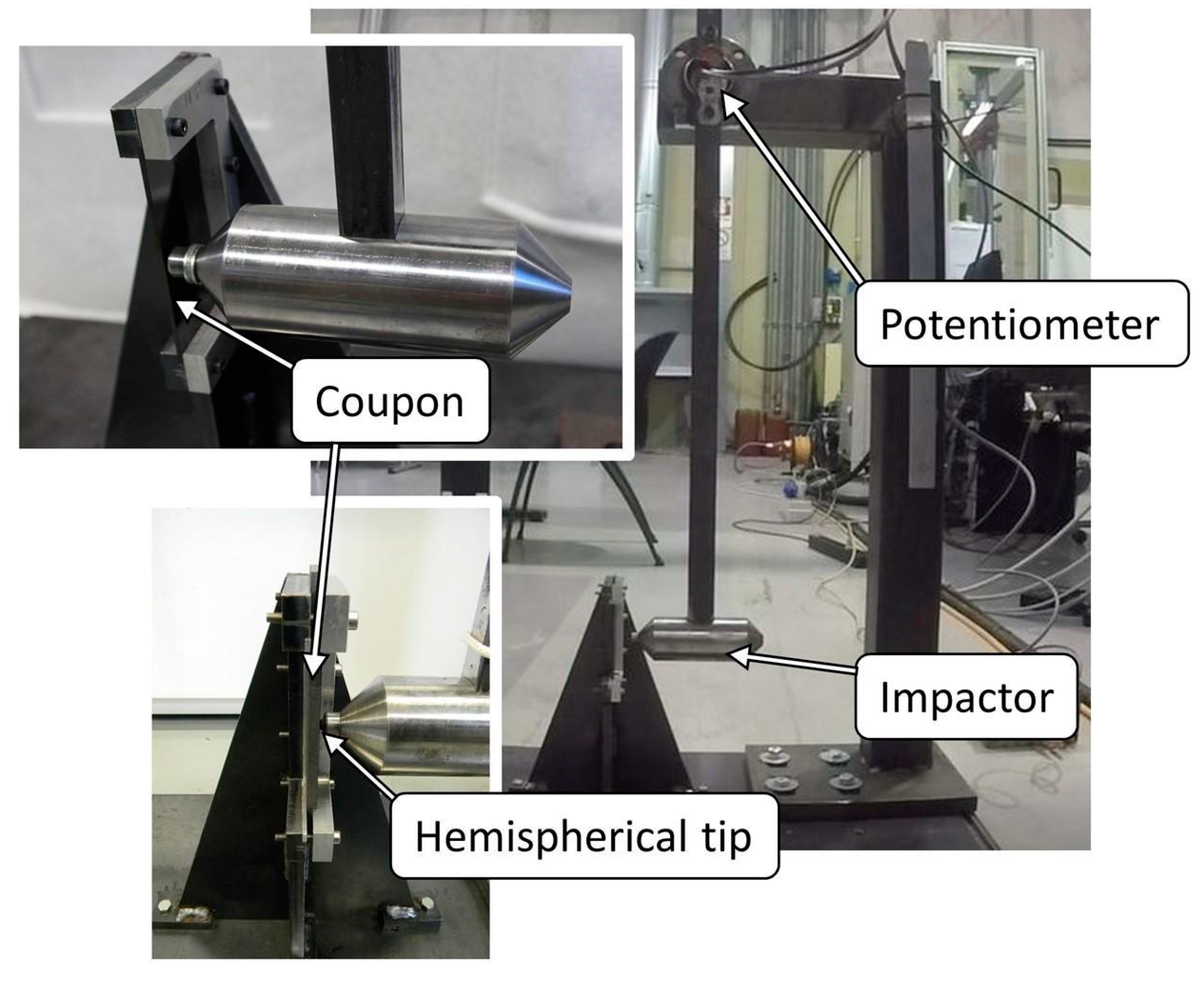
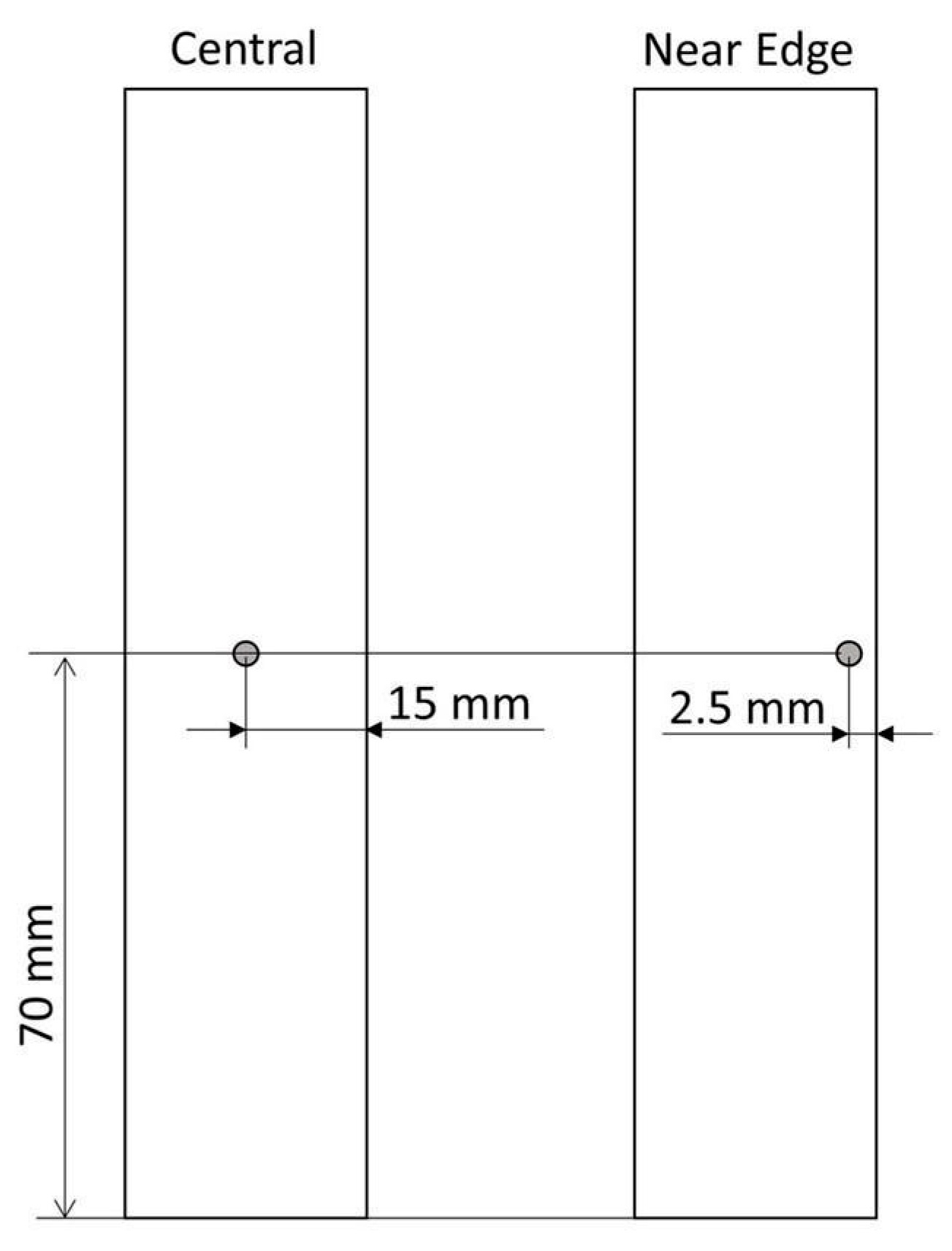
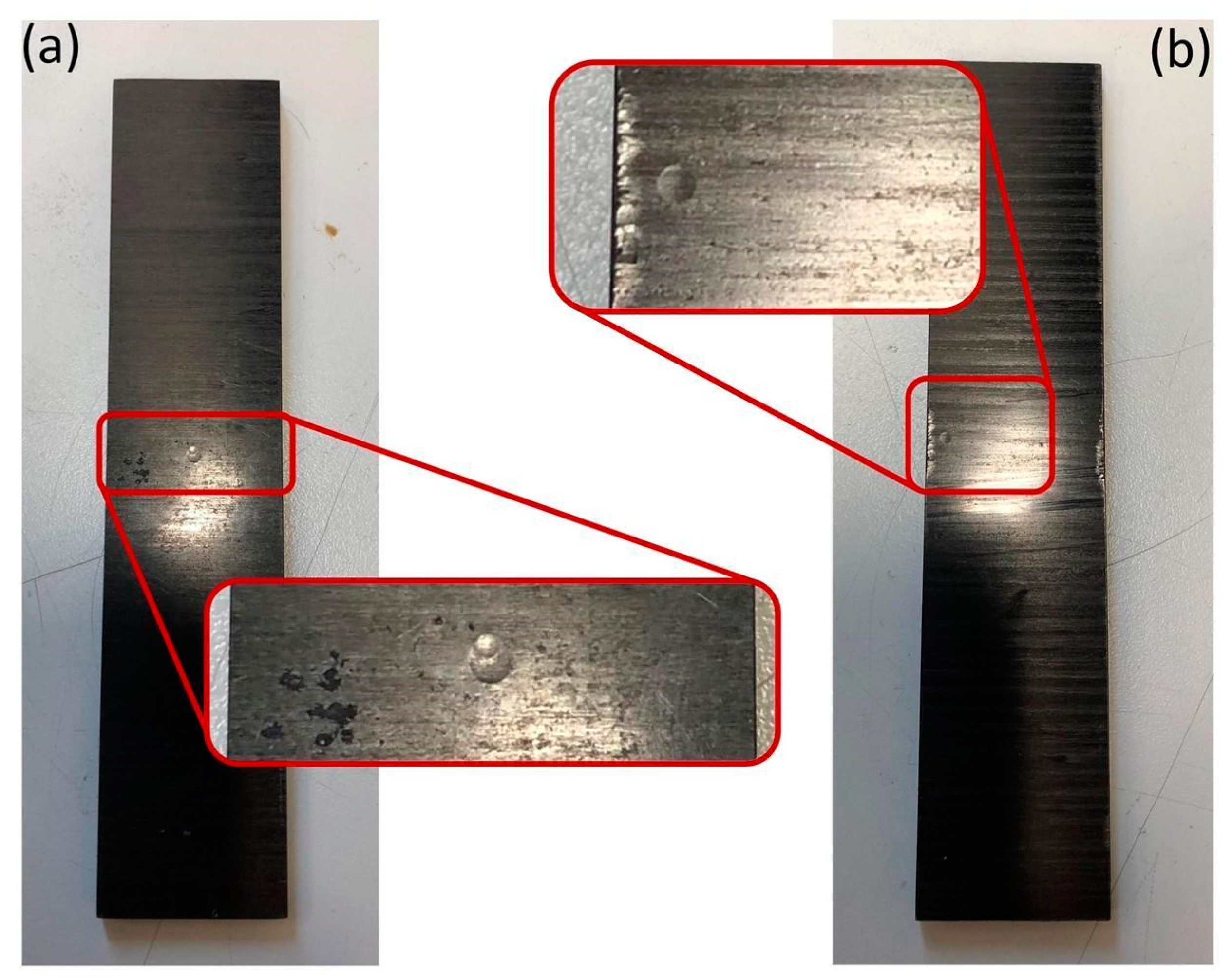
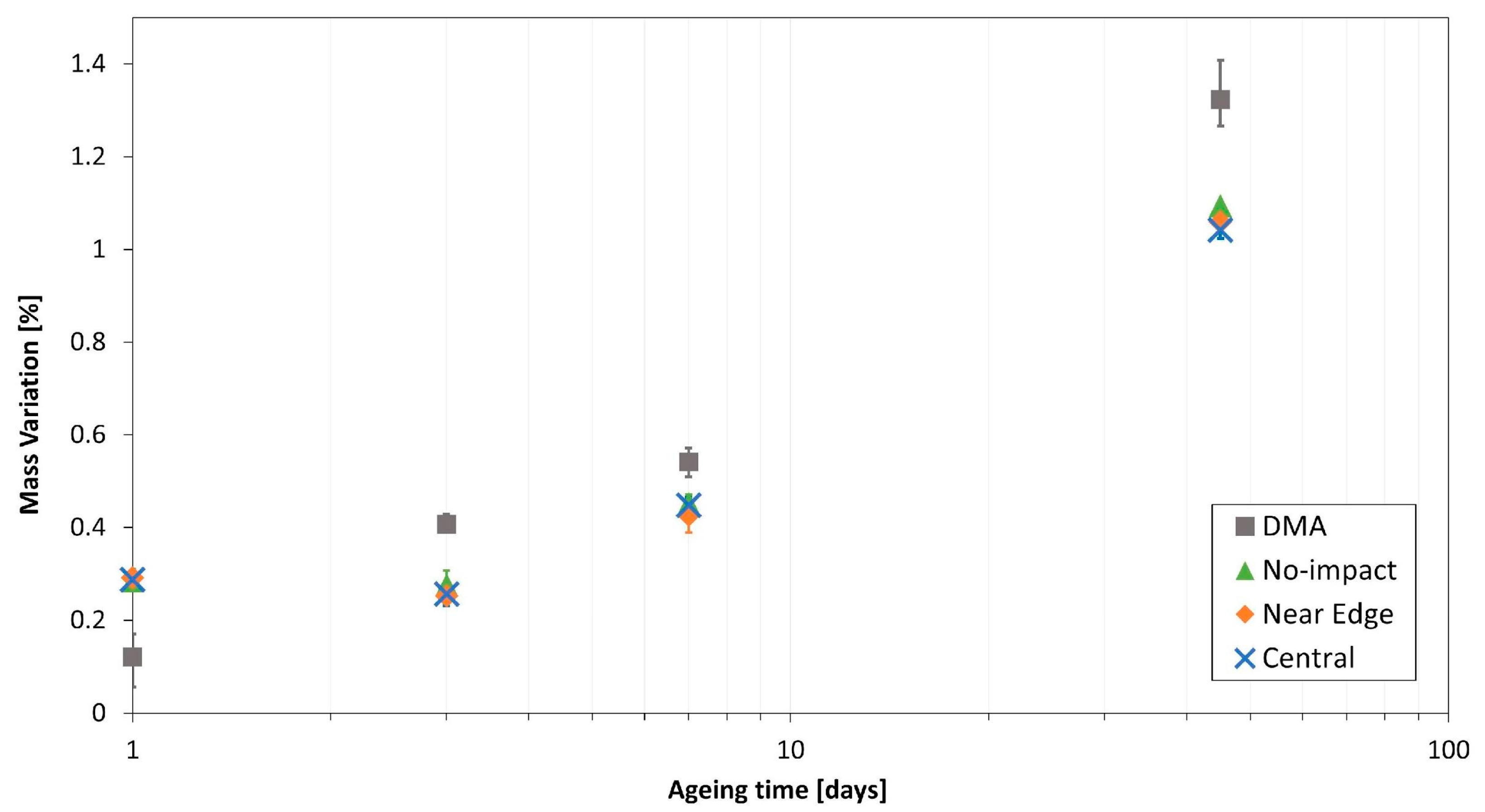
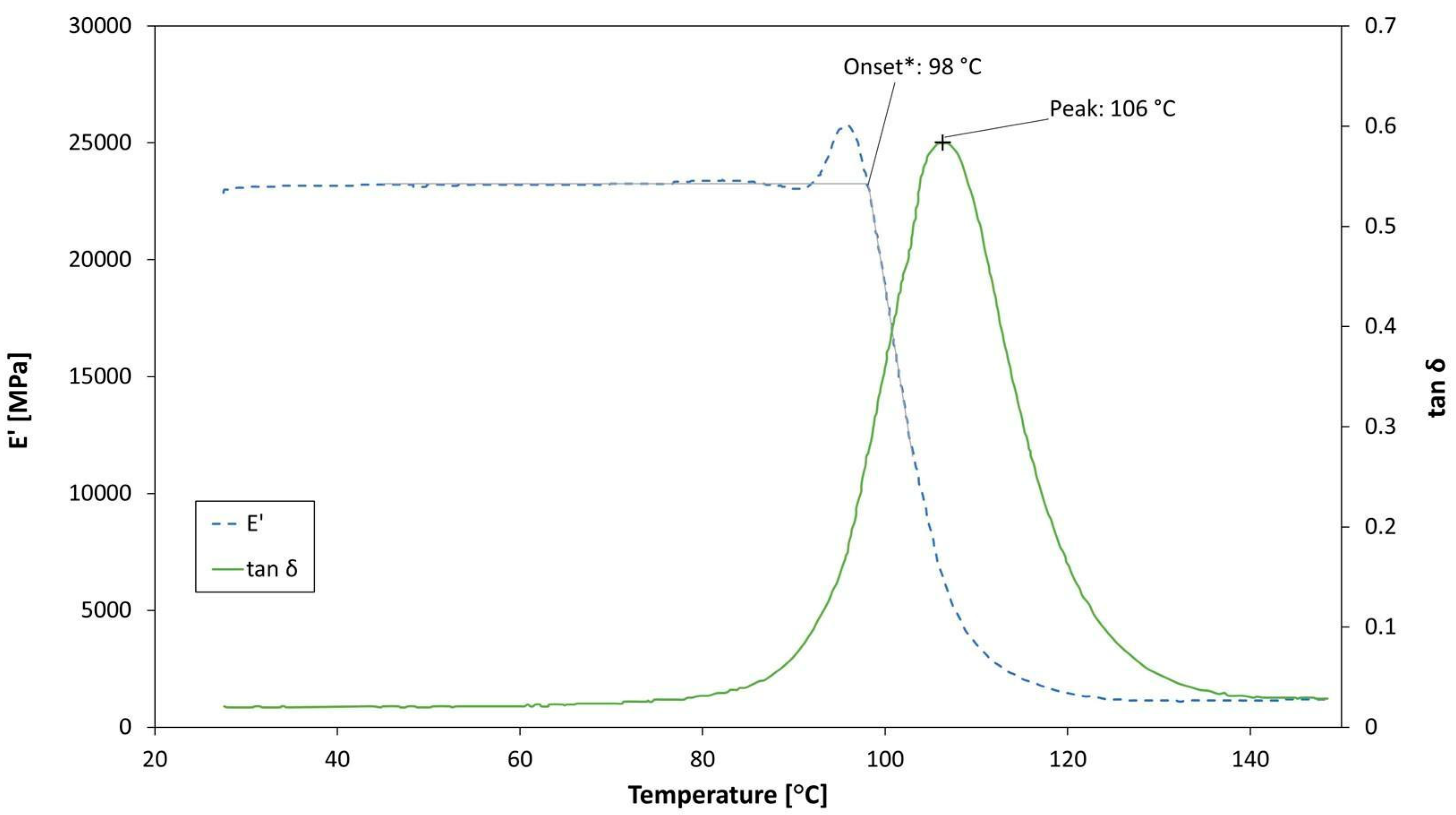
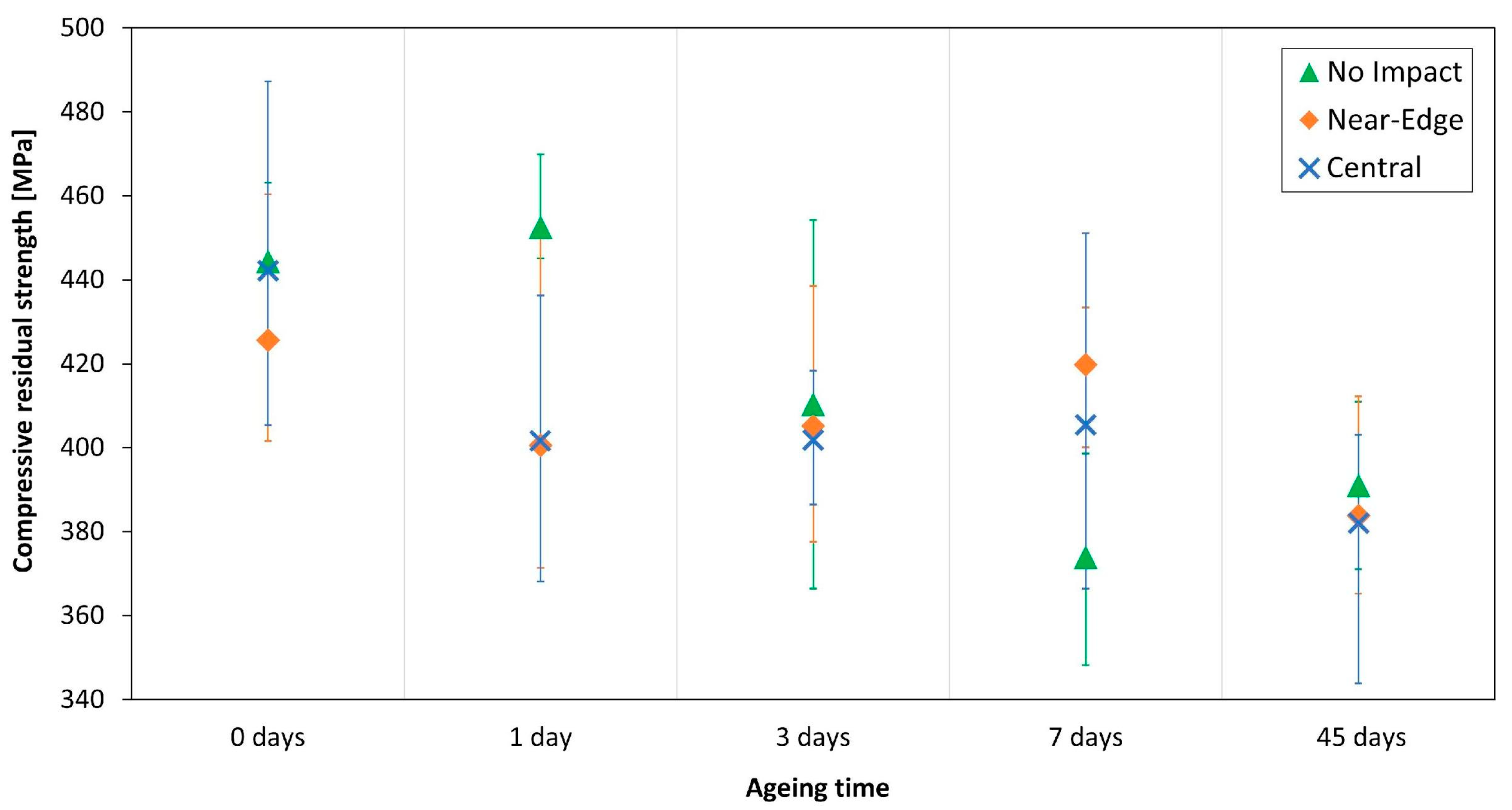
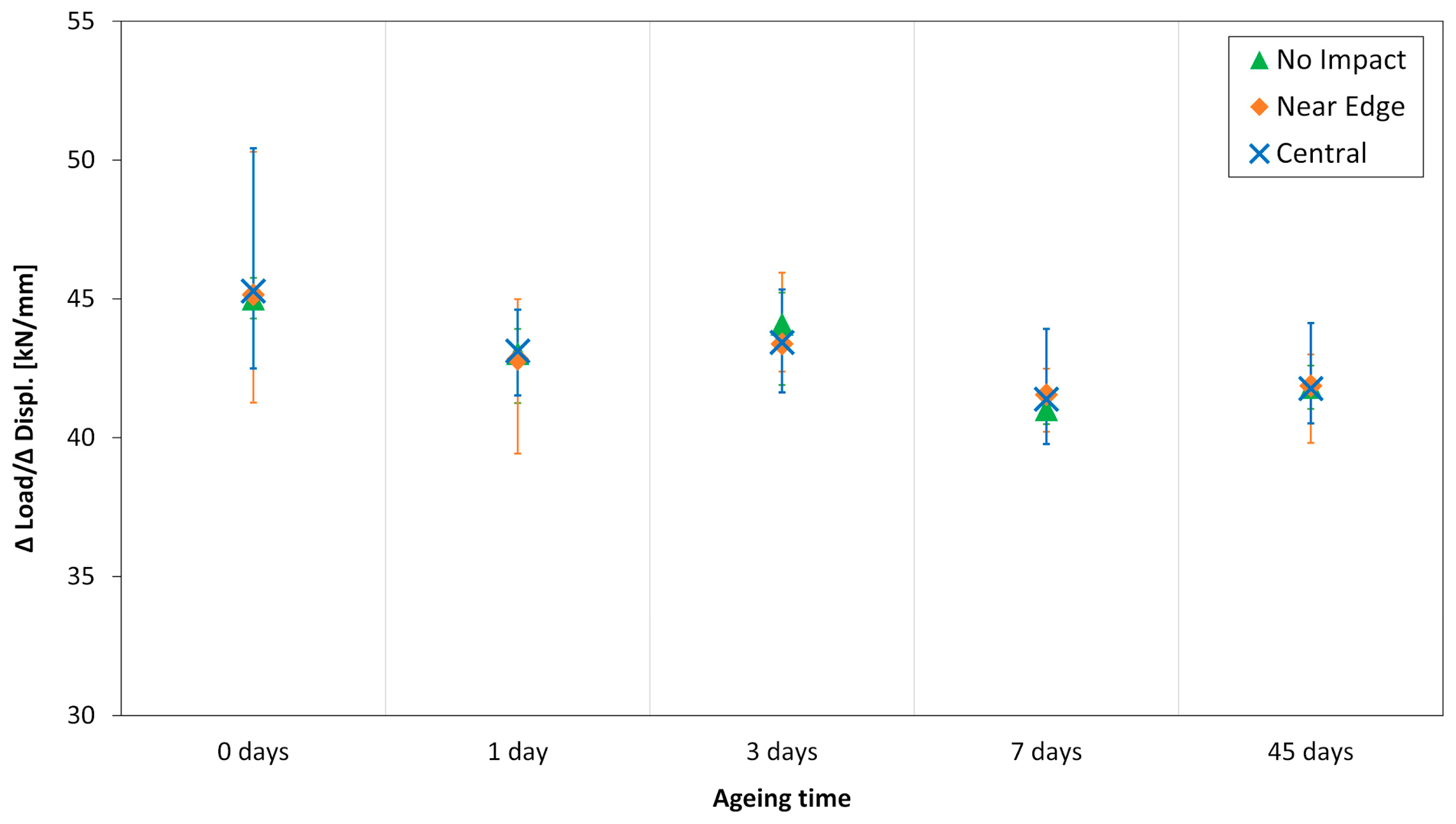
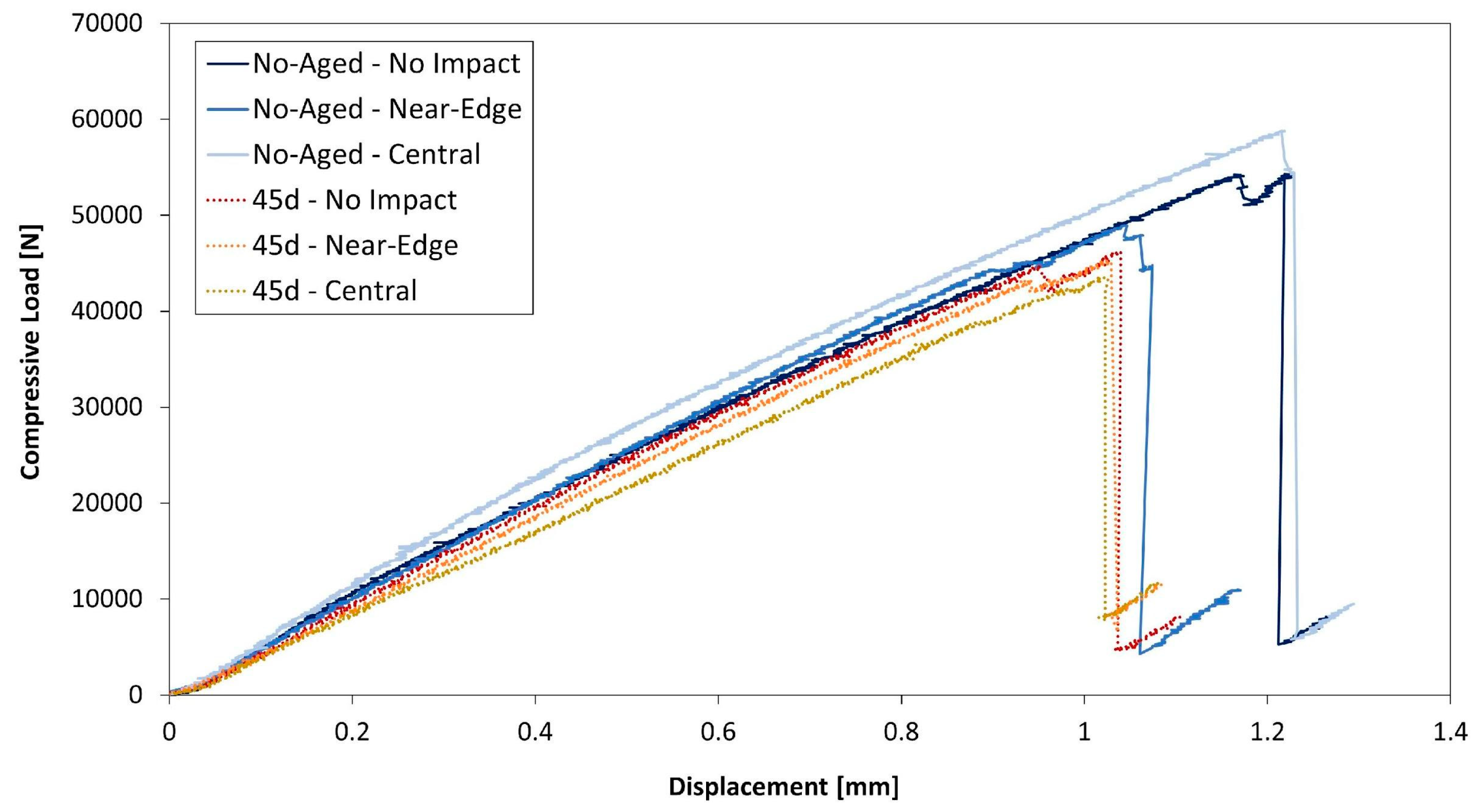
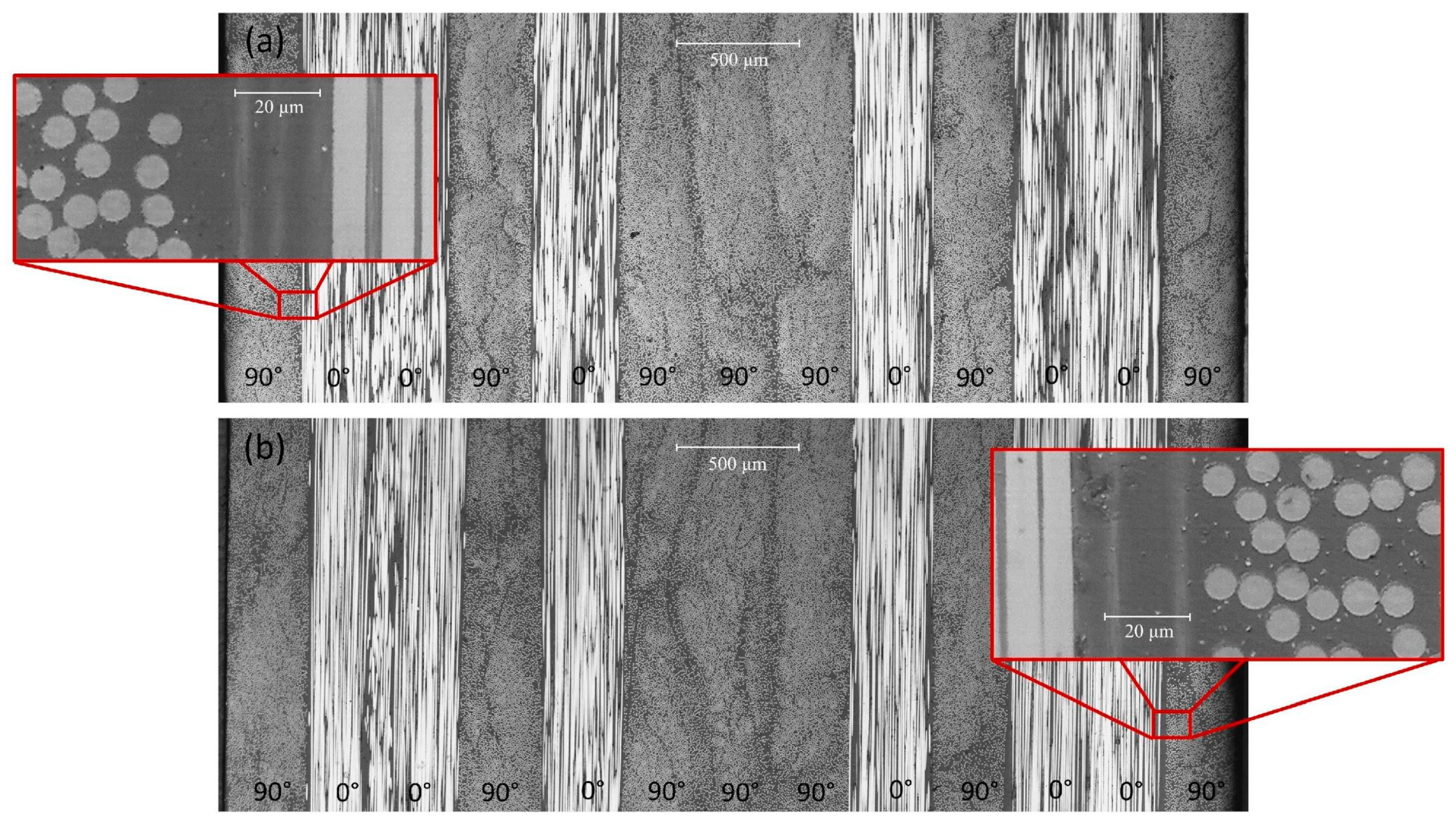
| Impact Area | Impact Energy [J] | Residual Energy [J] | Absorbed Energy [J] | |
|---|---|---|---|---|
| Central | Mean Value | 3.03 | 0.21 | 2.82 |
| Std Dev. | 0.02 | 0.05 | 0.05 | |
| Near-Edge | Mean Value | 3.03 | 0.33 | 2.70 |
| Std Dev. | 0.02 | 0.03 | 0.03 | |
| Ageing Time [Days] | Mass Variation [%]—Mean Values | |||
|---|---|---|---|---|
| No-Impact | NE | CI | DMA | |
| 0 | 0 | 0 | 0 | 0 |
| 1 | 0.29 | 0.29 | 0.29 | 0.12 |
| 3 | 0.28 | 0.25 | 0.26 | 0.41 |
| 7 | 0.45 | 0.43 | 0.45 | 0.54 |
| 45 | 1.09 | 1.06 | 1.04 | 1.32 |
| Specimen Type | Tg [°C] |
|---|---|
| 0 days—no ageing—reference | 116 |
| 1 day | 114 |
| 3 days | 111 |
| 7 days | 106 |
| 45 days | 98 |
| No Aged | 1 Day | 3 Days | 7 Days | 45 Days | ||||||
|---|---|---|---|---|---|---|---|---|---|---|
| Mean Value | Std. Dev. | Mean Value | Std. Dev. | Mean Value | Std. Dev. | Mean Value | Std. Dev. | Mean Value | Std. Dev. | |
| No Impact | 444.4 | 18.1 | 452.5 | 15.1 | 410.4 | 43.9 | 373.9 | 25.2 | 391.0 | 28.3 |
| NE | 425.6 | 24.5 | 400.6 | 31.3 | 405.2 | 23.5 | 419.8 | 13.7 | 383.7 | 20.4 |
| CI | 442.2 | 29.2 | 401.6 | 26.6 | 401.8 | 13.6 | 405.4 | 32.0 | 382.0 | 28.5 |
| No Aged | 1 Day | 3 Days | 7 Days | 45 Days | |||||
|---|---|---|---|---|---|---|---|---|---|
| Impact Δσ | Impact Δσ | Ageing Δσ | Impact Δσ | Ageing Δσ. | Impact Δσ | Ageing Δσ | Impact Δσ | Ageing Δσ. | |
| No Impact | - | - | 1.8 | - | −7.7 | - | −15.9 | - | −12.0 |
| NE | −4.2 | −11.5 | −5.9 | −1.3 | −4.8 | 12.3 | −1.4 | −1.9 | −9.9 |
| CI | −0.5 | −11.3 | −9.2 | −2.1 | −9.1 | 8.4 | −8.3 | −2.3 | −13.6 |
Publisher’s Note: MDPI stays neutral with regard to jurisdictional claims in published maps and institutional affiliations. |
© 2021 by the authors. Licensee MDPI, Basel, Switzerland. This article is an open access article distributed under the terms and conditions of the Creative Commons Attribution (CC BY) license (https://creativecommons.org/licenses/by/4.0/).
Share and Cite
Falaschetti, M.P.; Scafé, M.; Zavatta, N.; Troiani, E. Hygrothermal Ageing Influence on BVI-Damaged Carbon/Epoxy Coupons under Compression Load. Polymers 2021, 13, 2038. https://doi.org/10.3390/polym13132038
Falaschetti MP, Scafé M, Zavatta N, Troiani E. Hygrothermal Ageing Influence on BVI-Damaged Carbon/Epoxy Coupons under Compression Load. Polymers. 2021; 13(13):2038. https://doi.org/10.3390/polym13132038
Chicago/Turabian StyleFalaschetti, Maria Pia, Matteo Scafé, Nicola Zavatta, and Enrico Troiani. 2021. "Hygrothermal Ageing Influence on BVI-Damaged Carbon/Epoxy Coupons under Compression Load" Polymers 13, no. 13: 2038. https://doi.org/10.3390/polym13132038
APA StyleFalaschetti, M. P., Scafé, M., Zavatta, N., & Troiani, E. (2021). Hygrothermal Ageing Influence on BVI-Damaged Carbon/Epoxy Coupons under Compression Load. Polymers, 13(13), 2038. https://doi.org/10.3390/polym13132038









